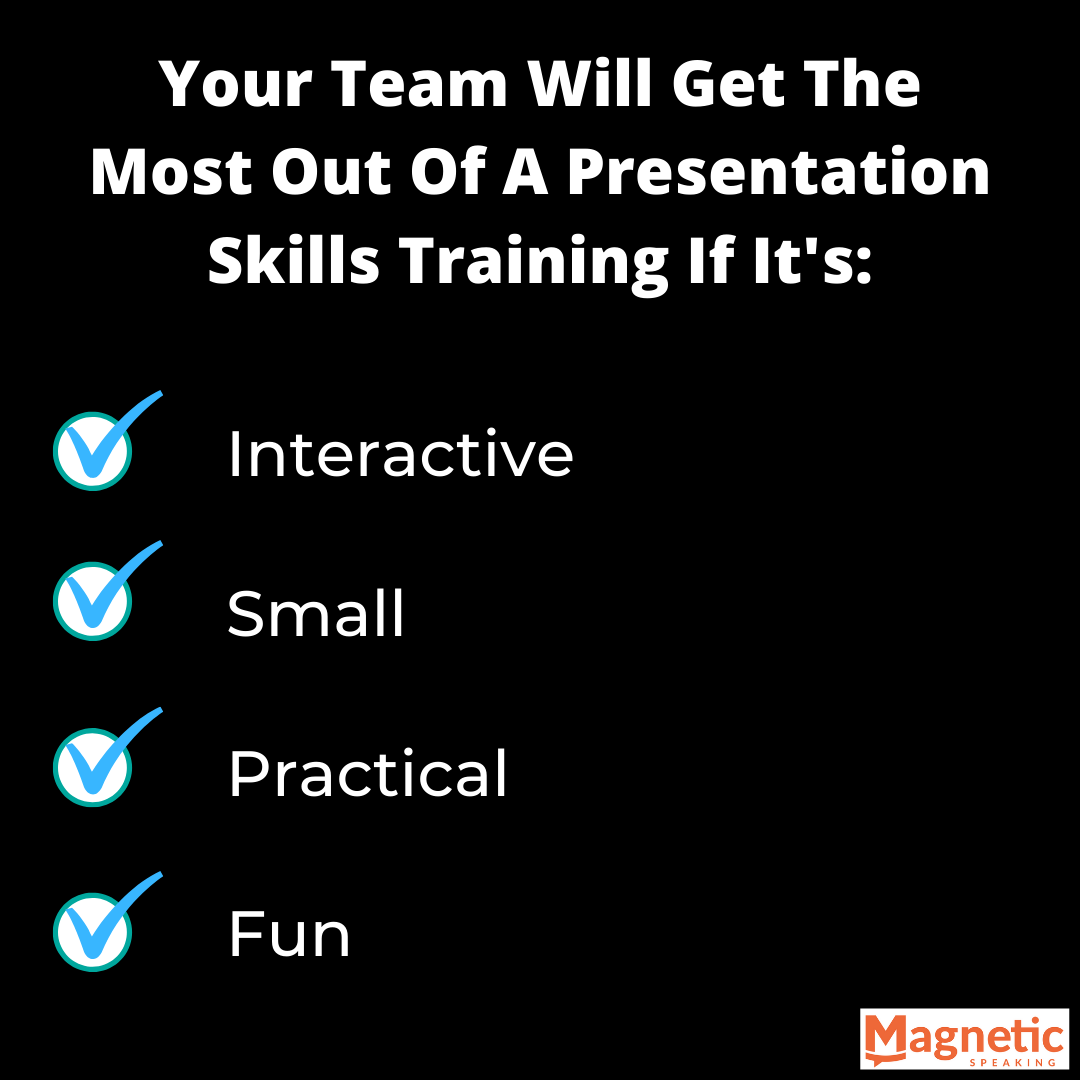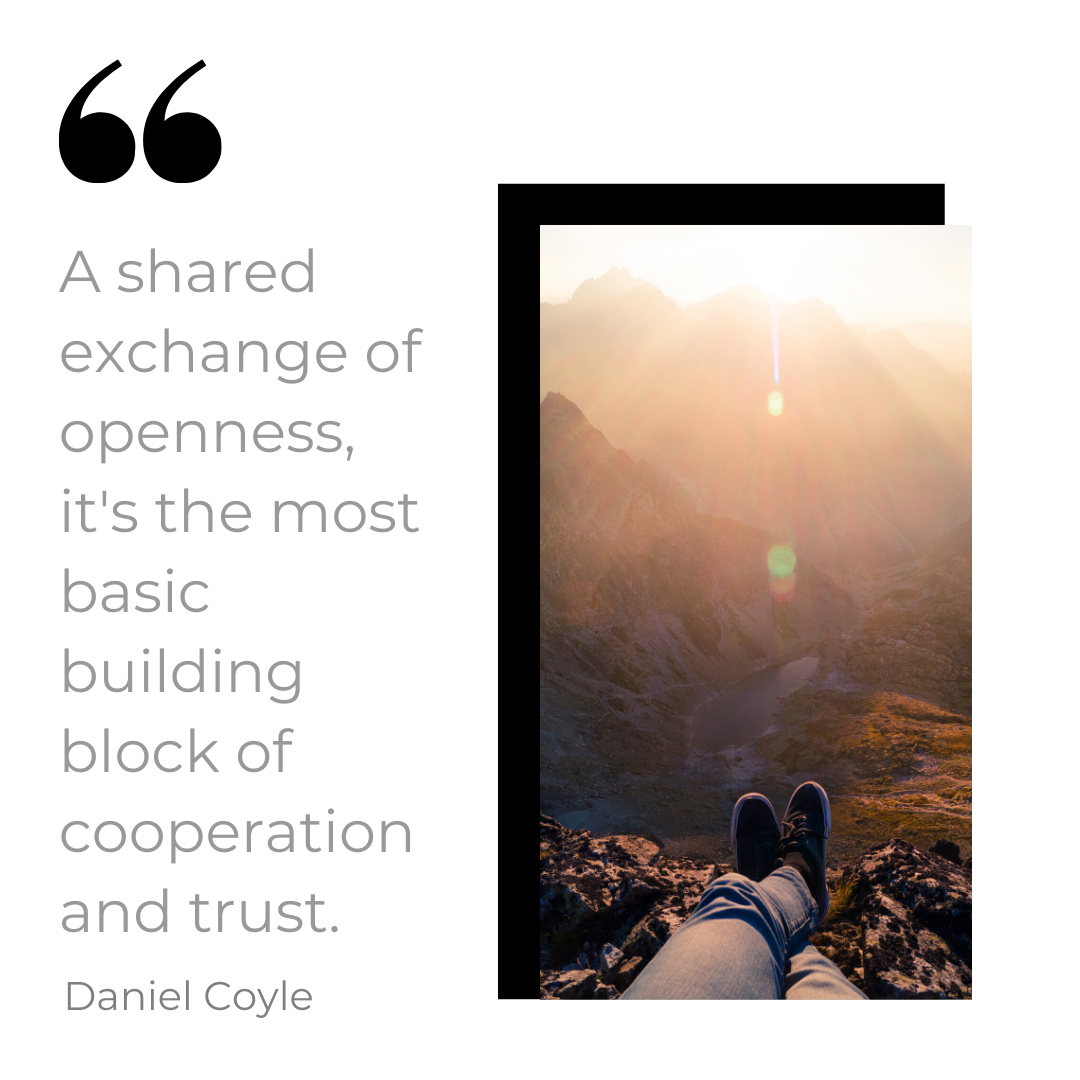Your employees may be subject matter experts in their field, but do they know how to communicate their ideas well? Public speaking, communication, and presentation skills are unfortunately not skills taught in school. So many of us grow up being experts in our domain but not having the skills to actually present our work (not to mention, likely having tons of fear around public speaking and presenting).
In this article, I’ll take you through key reasons why you should offer your employees presentation skills training. Within this list, there are 3 tiers I’ll address: the employee or individual level, the team level, and the organizational level.

Shatter the Glass Ceiling
Public speaking allows employees to flourish in their careers. Lack of public speaking skills is usually a glass ceiling in the organization. You see competent and smart professionals being held back at their roles, and not get the opportunities they deserve because they can’t communicate well. This adds unnecessary stress, resentment, and politics to the workplace and does not help anyone.
Public speaking training will unlock your employee’s career potential. It will allow them to sell themselves and sell their ideas better in the organization. Therefore people feel appreciated and expressed – leading to a more able workforce.
The public speaking training you provide will shatter yet another glass ceiling creating a healthier workplace for all.
Go From Professional to Leader
I always thought that “leadership is a moral obligation.” I say it because I noticed in my career that so many smart professionals hide in the shadows and complain and never take charge and change things. Because of that, things hardly improve in specific work environments.
It’s not that those professionals lack intelligence, or ideas, or moral code. Usually, it’s a lack of communication skills and confidence that prevent them from leading. Fortunately, arming smart professionals with the communication tools they need can create massive initiatives inside of companies for the better.
Give Them What They Want
Employees nowadays are asking for interactive, fun, and pragmatic training. Employees are busy doing their work, and the last thing they need is a theoretical framework that has no ties to their daily job. They want something easy to implement that delivers results.

The good news is that a small interactive public speaking training fits the bill. Notice I said small and interactive. The small class size allows for direct feedback from instructors and for more practice time. The “interactive” part provides for the participants to be engaged while putting what they learn into practice.
Competitive Advantage
Unfortunately, we, as a society, still judge a book by its cover. We also judge information on how it’s presented. We are biased towards the packaging of information rather than the substance. That’s why we still fall for scams, conspiracy theories, and corrupt politicians. I don’t think there is a cure for that bias anytime soon. So the next smart thing to do is arm bright ideas with a beautiful book cover and arm presenters with excellent public speaking skills.
Reduce Stress
You need the right amount of stress in your work to perform well. Understress and employees don’t feel challenged – Overstress and people get overwhelmed.
Unfortunately, public speaking is a very stressful activity for a lot of professionals. It exerts an overbearing pressure on a lot of individuals in organizations and leads to excessive anxiety and lack of productivity.

We have a lot of clients who, due to public speaking fear, left their jobs, are afraid of applying to specific jobs, are on anxiety meds, drink, and even take sick leave regularly. These professionals come to us seeking help because they know that their career is unsustainable if they continue without dealing with their public speaking fear.
For every person that seeks us out, I estimate that there are five more who are suffering silently. It could be because they don’t have the time, resources, or they are still in the denial stage. What a shame! It does not have to be this way for them.
Imagine how much stress relief you could provide your employees if public speaking training was part of your culture at work. People could get the skills and confidence they need and go back to a healthy stress level so that they can perform at their best.
Now that I’ve covered reasons to offer your employees presentation skills training that benefit the individual, I’ll move into the next tier which benefits employees at a team-level.

Employees Can Influence Clients More Effectively
When employees learn the skill of being able to present and communicate better they can influence more effectively. They can do this by sharing concise messages that are relevant to the client, telling customer success stories, knowing when to use data/graphs and how to set up their presentation to tell a story.
If it’s the first time an employee is giving their sales pitch to the client then it’s crucial to have that person as fully trained as possible. Having the sales professional do an excellent job will bring in more money to the organization which will in turn help it grow, open new training opportunities and take the company to the next level. If teams are being trained to present their best at an organizational level then the company will be putting its best foot forward through their employees, every time.
Presentation Skills Training Supports Team-Building
Offering your employees a group presentation skills training brings the team together and takes them through a shared experience they can bond over. This is especially true for presentation skills and public speaking because it’s interactive, and can feel more personal by nature. In the training they will have to share and open and authentically show their personality through fun and dynamic speaking exercises.
When team members show vulnerability to one another, trust is built. Jeff Polzer, Harvard Professor of Organizational Behavior, explains the concept of “vulnerability loops” and how when someone lets their guard down, it signals a green light to others to do the same, and a norm of openness and trust is built.

Saves Time In The Long Run
Presentation training will help save time for the team in the long run because they’ll be more efficient in how they prepare and present. For example, if they learn messaging and get a blueprint for how to put together a killer presentation, then they can quickly and easily plug in the relevant content.
The training may also help with reducing employee procrastination and anxiety with putting together a presentation. Often when people procrastinate it’s because some negative emotion is being built up in their mind about the task at hand. Studies show a correlation between fear of failure and procrastination.

Whether the negative emotion is fear, feeling of incompetence or something else, by equipping employees with the tools (and thus confidence) in their ability to put together an influential presentation, you’re doing employees a favor.
Training can also help save time because employees will learn how to present more concisely. Therefore when employees present internally they’ll be able to have more impactful presentations in less time.
Relevancy To Their Job
In almost any professional role in varying careers, employees will have to present and speak in front of everyone. The more they want to progress in their career and shift to leadership the higher the expectations will be around their abilities to present well and speak confidently to an audience.
For example, if a software engineer has been working on new features for an application and wants to show why it’s important to add, then she needs to convince leadership of its value. This may be done through a conversation initially but if the feature is big enough and starts to gain momentum that engineer will likely have to present to executives and colleagues to showcase its importance. If the engineer can’t convince others that it’s worth it, then it doesn’t matter how beneficial that feature might be or how much extra money it might bring in.

Leadership Already Values Public Speaking
By now you should be clear on many of the reasons why an individual and a team would benefit from a presentation skills training. There are 4 other reasons to consider when thinking about it from a company leadership perspective.
The first is that leadership already values public speaking! When asked about what soft skills they wanted L&D to focus on, executives and people managers ranked communication and leadership as the top 2. They know it makes employees more effective and saves the organization’s time.
From their own leadership roles, they understand that it’s a huge part of their role. From media interviews, panels and all-hands meetings, the leadership of any company has to consistently speak. And they understand that a huge part of their role is effectively communicating and influencing. Because of this, there’s less convincing you need to do about whether it’s generally valuable.
Of course, if leadership doesn’t easily see this, you can always refer to the individual and team reasons.
Common Language Within the Organization
Whether it’s a sales, brand, engineering, etc., employees are going to be presenting their work to their managers. Something we hear about from leaders and managers is that they struggle with not having a common framework and language to coach everyone.
With a cohesive, end-to-end presentation training, managers would be sharing the same language with their teams and even across teams. Feedback would be more precise and actionable, and managers would have an easier time evaluating how each of their team members are doing with their presentations.
After our trainings, some managers have even been inspired to take on the training and coaching of the team themselves because they have a reliable framework to work through. Imagine the impact of every manager in the organization being able to coach their teams on presentations! Presentations would be efficient and influence more easily, saving more time in the long run.
Aligns With Long-Term Development
Speaking of the long run, another perspective that leadership holds is long-term development (and therefore retention) of employees.
Are employees growing and learning each year at the organization? Are they being challenged to learn new skills?
As we mentioned earlier, this type of training will always be relevant to their role. With a long-term view, it will be relevant to any role they’ll have in the future. That’s undeniably powerful.

And employees understand this. In the LinkedIn Workplace Learning Report, 94% of employees said they’d stay at a company longer if the company invested in their career. What better way to invest than to give them skills they’re going to use for the long-term?
More Clear When Presenting to Leadership/Cross-Functional Teams
With QBRs (Quarterly Business Reviews), project updates and company events (just to name a few), your company’s leadership is constantly listening to presentations. And I’d venture to say that many of these presentations don’t end up being a good use of their time. The content is either too detailed or doesn’t have a strong narrative that makes it easy to understand.
It’s no one’s fault – presentation skills are just a different skill than their domain expertise.
By offering presentation training, employees will save leadership’s time and be clear on the value their projects are providing to the company. And if they’re in cross-functional meetings, employees will be trained to speak to different types of audiences effectively and get their message across.
Conclusion
So there you have it. Whether you’re thinking about individual employees, managers or leadership, there’s many reasons why you want to offer presentation skills training. It’s a practical investment that everyone in the company will appreciate and continue to reap the benefits from years later.
If you’re convinced that it’s the right step for your teams, consider our Messaging Training, where we teach professionals how to construct a presentation from beginning to end with a 7-step “Blueprint System.”




